How to care for a flower in case of problems
Does not grow
- Most likely, your tree does not receive the required complex of nutrients. In the phase of intensive growth, fertilizing the flower with a complex mineral fertilizer will have a beneficial effect.
- Also, a cramped pot or lack of air in the soil may be the cause. Due to frequent watering, the earthen is compressed, which makes it difficult for the roots to breathe, so it is good to carefully remove the plant from the pot, slightly stir up the clod of earth, carrying out a kind of loosening of the soil. You may need to be transplanted to a more spacious "home". It should be just transshipment, because it is less stress for the flower.
- Poor location may also be to blame. The most favorite places of the flower are in the south and southeast.
The flower dries up or leaves fall from it
- The most common option is overflow or lack of moisture. Check these procedures. When underfilled, the leaves first turn yellow and then fall off. Excess water can affect the roots - they will begin to rot.
- If a flower transplant was carried out with a complete replacement of the soil, then this process is most likely as an outcome. The reason for this is the damaged root system of muraya. In this case, it remains only to regularly water, putting it in a sufficiently illuminated area, and also spray. You can try using root.
- If the leaves of the muraya fall off, there is also an option that the top dressing with which you decided to feed the plant is not suitable for it. Muraya fertilizer should be used as for citrus fruits.
- Why else is muraya dropping leaves? The plant is frozen or stands in an area with an unstable temperature regime. Place the flower on the south side, protect it from drafts.
Does not bloom
- Find out what kind of plant you have. There are decorative varieties that, in principle, do not bloom or bloom relatively rarely (for example, Japanese, Dutch, and others).
- The plant needs feeding.
- Cramped pot, lack of lighting and watering.
Despite these problems, many growers choose muraya as a favorite plant in their home garden. Still wondering whether to grow the imperial flower? Once you enjoy the scent of muraya, you will make the right decision.
Varieties of muraya
Muraya is a tropical plant and naturally grows in the following regions:
- Southeast Asia;
- South Asia;
- Philippines;
- Indonesia;
- Polynesian Islands.
The genus Murraya includes about 8 species, of which the most common are Koeniga and Muraya paniculata.
Interesting!
The plant has some medicinal properties and is widely used in alternative oriental medicine recipes.
Muraya Koeniga
In a complex leaf blade, the leaves are arranged in pairs, of which there are from 11 to 20 in total along the cutting.
This type of muraya blooms with small flowers, whose color is white or white with a slight creamy tint.
The aroma is intense and pleasant. When ripe, the fruits acquire a dark blue or black color.
Important!
The seeds of the plant are poisonous, but the fruits are edible.
This type can be applied in the following areas:
- The foliage has a very fragrant scent and is one of the ingredients in curry, which is used in virtually all lunch and salty dishes to increase appetite in the humid, sultry areas of muraya. In the fresh version, the leaves are added to all dishes, due to which the food acquires a more delicate, but specific aroma.
- Steam distillation produces oil from the foliage of the Koenig species, which acts as a common soap perfume.
- Murayi König wood, which is distinguished by its strength and hardness, was previously widely used in the production of agricultural tools and a variety of handicrafts.
- Foliage has become widespread in traditional and Ayurvedic medicine in South Asia as a raw material with medicinal properties - anti-cancer and anti-diabetic.

From the foliage of Murayi Kyongge, decoctions are also produced, used in the treatment of gastrointestinal diseases and certain skin diseases.
Muraya paniculata
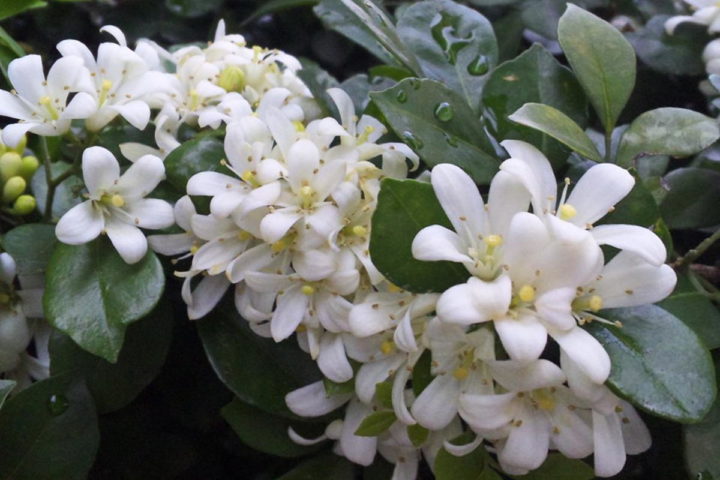 Muraya Mogra
Muraya Mogra
This species is the main one among those that can be grown at home. Also, this variety is called Mogra.
Also, there are a number of synonyms that also denote the described plant species:
- Muraya is exotic;
- Orange jasmine;
- Orange jasmine;
- Japanese myrtle.
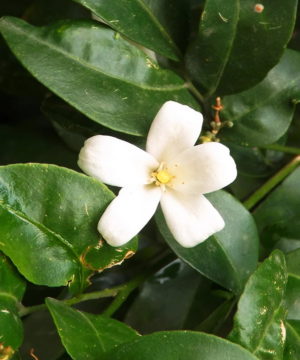 Since mogra is actually a constantly flowering plant, in India its flowers are used to offer living necklaces and jewelry.
Since mogra is actually a constantly flowering plant, in India its flowers are used to offer living necklaces and jewelry.
During marriage ceremonies, women adorn their hair with these flowers, and it is also widely used in decorating sanctuaries and temples during various festivals and festivals.
In addition to this, the sap of the flower, which retains the scent of Mogra flowers, is used by the inhabitants of the regions where the plant grows, as a perfume.
Murraya paniculata is a tub culture for enclosed spaces.
Its height fluctuates within 0.7-1.5 m. The bush is formed in the form of a bonsai or tree.
Perennial branches and trunk are embossed, in color they resemble white marble.
The leaf plates are deep green, glossy and small. In bright light, they can cast golden and perfectly set off the snow-white or white-cream flowers - in the apical inflorescences or single.
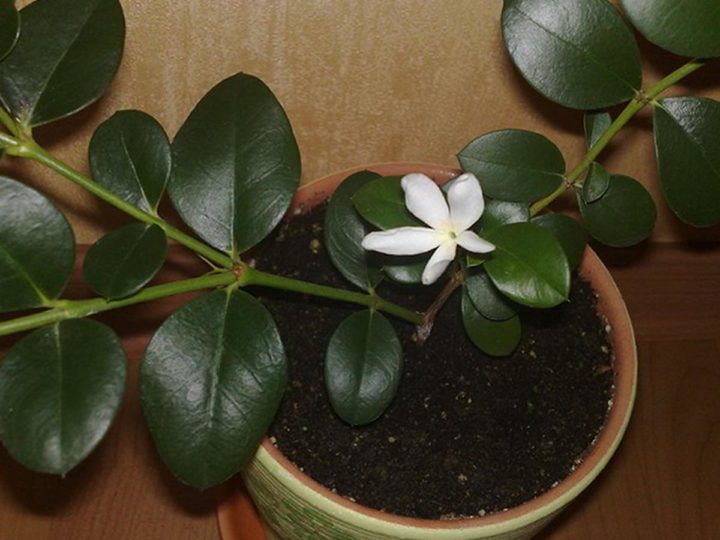
The flowering period of the plant is actually year-round, occasionally there may be breaks of 2-3 months. This interval falls on November-January.
The flowers have a strong, pleasant smell, and even 1 blooming is enough to fill the room with a citrus-jasmine aroma, which does not provoke headaches and other disorders of health of an allergic nature.
The plant of this species has a difference - it begins to bloom very early - the first flowering in the life of Muraya paniculata starts 2-4 months after the appearance of the first seedlings.
Important!
If during this period the plant has not even formed 1 bud, then this is a false muraya.
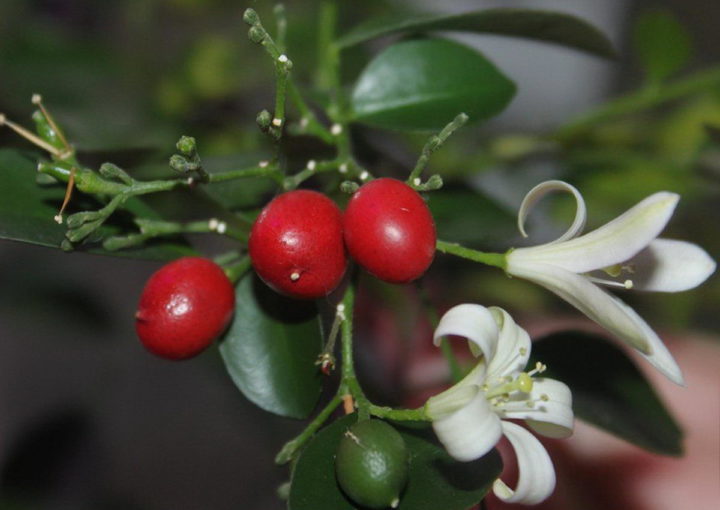
The fruit has an intense scarlet color, the pericarp is completely edible. These berries keep on the branches for a long time and are characterized by strong tonic capabilities.
Characteristics of a murayi indoor flower (with photo)
|
Genus |
Murraya |
|
Family |
Root |
|
Homeland |
India, Indochina |
|
Escape type |
In young plants it is fleecy, in adults it is smooth. Lignifies over time |
|
Inflorescence |
Paniculata |
|
Petal color |
White |
|
The structure and color of the leaves |
Complex, consist of small elliptical leaves of a rich green hue |
|
Flowering period |
All year round |
|
Fetus |
Rounded sweet berry of red or black color |
|
Reproduction |
Seeds, cuttings |
According to its characteristics, muraya is a perennial small evergreen tree or shrub that grows from 30 to 150 cm under indoor conditions, depending on the species. It has a lush spreading crown. Branching shoots, thin, smooth, covered with yellow bark. Young plants have a small white pile on the shoots.
In the first years of life, the bush grows very slowly, but as the root system develops, its growth increases. Adult specimens quickly form new shoots that grow in height and width. The annual growth of the shrub is 7 cm or more.
Murai leaves are oval or elongated-oval, compound, consist of several small leaves. The length of each such sheet is 1 - 8 cm, the width is 2 - 5 cm. The length of the entire composite sheet is 12 - 15 cm.The leaf plates are dense, fleshy, smooth, shiny, bright green, slightly bent back.
Inflorescences are panicles. Formed at the top of the shoots. They consist of five-petalled white flowers with a diameter of 1 - 1.5 cm. In the central part of the flower there are long filamentous stamens. The flowers have a strong, very pleasant aroma.
After pollination of the flowers, fruits are formed on the plant - smooth, rounded berries with a dense skin of red or black color and sweet pulp. Their diameter is 2 cm. The fruit contains 1 - 2 long seeds. Muraya berries are not only edible and tasty, but also very useful, their ripening lasts for 4 months. It is noteworthy that this culture blooms and bears fruit at the same time throughout the year.
Growing from seeds
Murray seeds for planting must be fresh, since they quickly lose their germination. It is best to place the plant pot on the west or east window.
Murraya grows flowers in 3-5 months after planting, and blooms for a very long time, from March to October. After that, large orange-red berries appear. It is the seeds of these berries that are the seeds.
Reproduction
Murraya can be propagated by cuttings and seeds. The plant reproduces by cuttings poorly, and they take root for a long time. They are cut from the top of the shoot and rooted in wet sand, under a film.
After a month, the roots appear, and the murraya is transplanted into a separate pot.
The seeds of the plant are cleaned of pulp, dried and planted in spacious containers filled with prepared soil. They are left in a well-lit place, at t + 23-25C, covered with glass, periodically sprayed.
In a couple of weeks, the first shoots of Murray will appear. They are seated in small plastic cups.
Temperature
Attention! Murraya cannot stand high temperatures.
The optimal condition will be a temperature not higher than + 25C in summer, and about + 15-17C in winter. The plant does not like drafts or sudden temperature changes.
Lighting
Attention! Lack of light, as well as excess, is harmful to murraya.
It should be shaded a little from direct sunlight.
But daylight hours must be at least 14 hours. Therefore, if necessary, the murraya is illuminated with special lamps.
Features of the use of a houseplant in other situations
In cooking
The use of the leaves in cooking is very common due to its strong citrus-lemon scent. Murraya chokeberry leaves resemble curry and are used in cooking. Its scent complements the taste of food. Murraya is suitable for additions to salads and appetizers, to vegetable and meat dishes. The medicinal properties of the houseplant are wide: heart disease, high blood pressure.
In cosmetology
Now, in face and body care, women prefer natural remedies, which are abundant in the plant world. It is unlikely that anyone will be surprised that such a unique plant is successfully used in cosmetology. Fresh leaves are the main source of cosmetic applications. 3-5 Murayi fruits eaten daily is the prevention of aging of the body. The skin will be hydrated and elastic for a long time. Decoctions from the inflorescences of the plant have a beneficial effect on the fading skin of the face. To prepare the broth, you need a handful of inflorescences, which are poured with boiling water, they insist for several hours. In the morning, this infusion is used to wipe the face. The solution can be stored in the refrigerator for several days. The result from this procedure will be noticeable quickly.
To improve the quality, the essential oil of this plant can be added to hair shampoos, creams, balms, 3-4 drops per spoon of the base. One of the useful face masks: Muraya essential oil and turmeric. This is a healing mask that helps to get rid of acne. The skin on the face will become clean and elastic, the pores will tighten. Apply this mask to problem skin. For hair, you can make a natural dye from foliage and coconut oil. All this needs to be boiled.This composition paints gray hair, strengthens the hair roots, improves their growth. Girls in India are known to have healthy and long hair. They use special masks based on Muraya leaves.
At home
Murayi has found its application in everyday life. How a beautiful ornamental plant decorates the house. Bonsai can be created from dwarf varieties. Chokeberry Muraya repels insects. Having a wonderful smell of flowers and leaves, it can be used to prepare ingredients for the preparation of perfumes. Muraya is one of the most unpretentious indoor plants. It is now easy to buy a bush in a store and it is inexpensive, and in return you will receive a fragrance, smell and joy for the eye.
Houseplant care
Exotic muraya feels good in certain conditions, create a suitable atmosphere for her and she will delight you for more than one year.
Illumination
Diffused light is best suited for the plant, but in summer you can take it outside or on a balcony in direct sunlight for 2-3 hours a day in the mornings or evenings. The rest of the time, keep the pot on the south window.
Temperature
In summer, the ideal temperature for Muraya will be 23-25 degrees. At this time, the plant blooms profusely and needs additional care. In winter, there is a dormant period, so the temperature should be reduced to 17 degrees.
Pruning
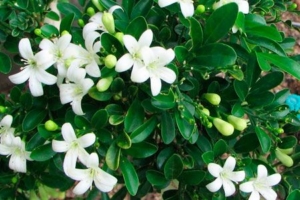
Muraya paniculata does not require pruning.
Periodically, you can get rid of old twigs so that the young get more nutrients.
How to water?
During the period from spring to autumn, the tree must be watered abundantly, but make sure that no water stagnates in the soil. It is ideal to irrigate the next time when the ground is one-third dry. In winter, the plant is watered much less often, once every 2 weeks is enough.
Air humidity
It is not required to create additional air humidity for muraya, even in conditions of heating with batteries. But it doesn't hurt to spray the leaves to give them a fresh look. Muraya is good at such procedures.
Fertilizer
In winter, the plant does not need fertilization, but this must be done during the flowering and ripening period.
From April to September, twice a month, you need to feed muraya with liquid complex fertilizers
It is important to ensure that they contain magnesium and calcium. It is also recommended to alternate organic and mineral supplements.
Transfer
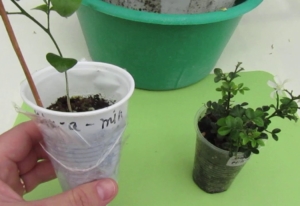
Young muraya bushes, which are from 1 to 3 years old, need to be replanted annually
Adult plants over 5 years old are transplanted if the soil is damaged. The rest of the time, it is enough to change the top layer of the earth annually.
When replanting, it is important to choose the right pot and soil. The pot must be stable so that the growing plant does not accidentally overturn
Its size depends on the size of the root system. After transplanting, approximately 1/3 of the free space for the soil should remain in the pot. As for the land, the mixture should consist of:
- 1 piece of leafy land;
- 1 part of sod land;
- 1 part sand;
- 0.5 parts of humus.
From the video you will learn how to transplant murayi:
Bloom
At home, muraya blooms as abundantly as in the wild. The period begins in the spring. The inflorescences of the plant are creamy in color and reach a diameter of 2 centimeters. During the flowering period, muraya smells profuse. 3-4 days after the bud opens, red berries appear in its place. They mature for several months before becoming edible.
Why can't it bloom?
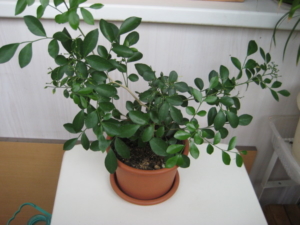
Muraya may not bloom for several reasons:
- some varieties begin to bloom at the age of 3-4 years;
- the plant lacks food or potting space.
Do not lose sight of this symptom, if you notice the absence of flowers, take measures to eliminate the problem, otherwise the plant will die ahead of schedule.
Muraya: flower description
In indoor conditions, Muraya paniculata is most often grown (see photo in the article).It is a fast-growing shrub with feathery, fleshy leaves of rich green color. If you grind the plate, you can smell the citrus scent.
The trunk is embossed, light marble shade. Young shoots are covered with soft down, adults are smooth.

Snow-white or milky flowers with five petals form at the tips of the branches. Single or collected in inflorescences, 1.8-2 cm in diameter. They are replaced by edible elongated berries of a bright scarlet hue, 1.5-3 cm in size, slightly resembling hawthorn in shape. The ripening period lasts 4 months.
At home, several types of Muraya paniculata are grown:
- "Dwarf". It is distinguished by miniature leaves, which are collected in 3-5 pieces and form a complex sheet. The trunk is slightly curved, strongly branched. The height of an adult tree is no more than 50 cm.
- Slightly larger than "Min-a-min". Its complex sheet consists of 5-7 plates. The plant is sterile and does not produce seeds during flowering.
- Quite a tiny variety "Dwarf Compact". Stretches no more than 15 cm in height, leaf diameter up to 5 mm.

Very often you can find an advertisement for the sale of the "Dutch" look. In fact, this is not a separate variety, but just a flower brought for sale from abroad.
Muraya Koeniga in nature grows up to 6 meters in height, trunk girth is 40 cm. Inflorescences have up to 80 flowers, emitting a strong aroma. Black berries are not eaten. Despite the fact that the pulp is edible, there is a poisonous seed inside the fruit.
Interesting: Ficus Benjamin: home care, reproduction, diseases
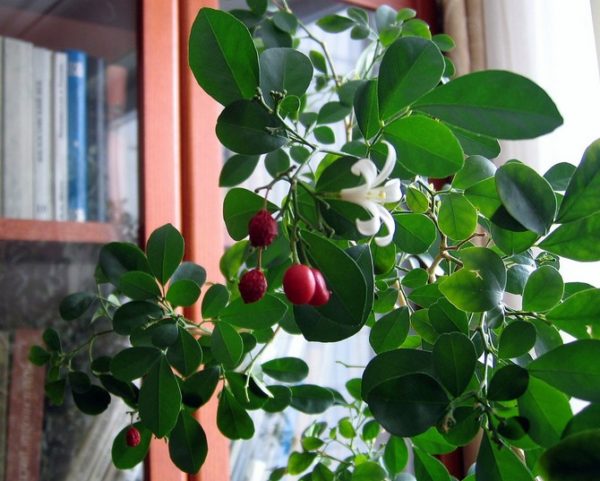
Interesting! Muraya, aka Japanese myrtle and orange jasmine, blooms almost all year round. Indian girls decorate their hair with flowers during marriage ceremonies, make living necklaces, decorate temples and sanctuaries for various holidays and festivals.
Propagation of Muraya by cuttings
The procedure is carried out in early spring or in September-November in several stages:
- Cut into cuttings, 15 cm long, semi-lignified one-year-old apical shoots. Shorten large leaves 2 times.
- Prepare small containers (you can use plastic cups) by filling them with a mixture of peat and sand, taken in the same amount. Instead of peat, it is allowed to take leaf or humus soil. The soil mixture should be sifted first, getting rid of large breasts and not rotted residues. Cuttings can also be rooted in a peat tablet, perlite or purified water.
- After the procedure, cover the container with the handle with a cap capable of transmitting light. You can use plastic wrap, a glass jar, or a cut-off plastic bottle. Ventilation should be carried out systematically.
- Until roots appear (approximately 1 month), it is necessary to maintain a moderate soil moisture and soil temperature between 26-30 ° C using bottom heating. The lighting should be adequate, but not in direct sunlight.
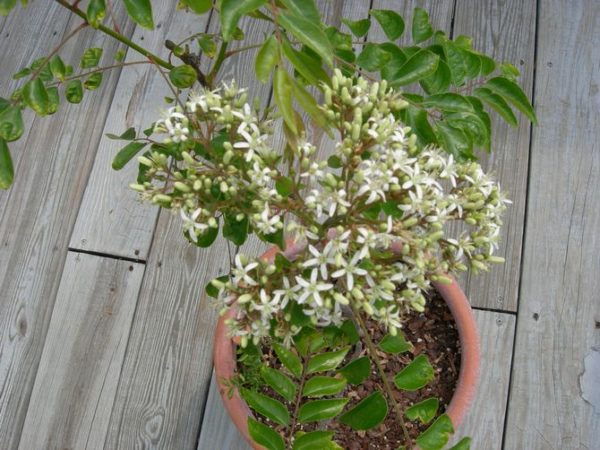
After the appearance of several young leaves, the cuttings are planted in pots with a diameter of 7-9 cm.
Note! With this method of reproduction, rooting is quite difficult. Therefore, after cutting the cuttings, they should be treated with "Kornevin".
Muraya properties: harm and benefit
The healing properties of muraya
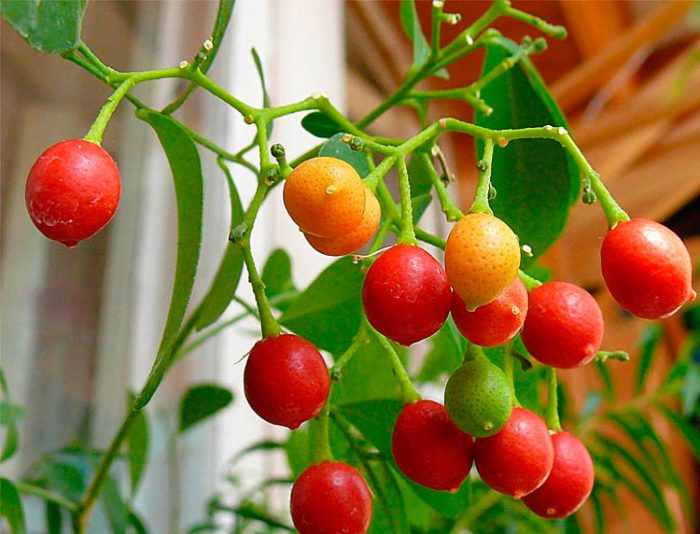
Already in ancient Egypt, they knew that muraya has medicinal properties. There are many myths about this plant, and the history of its origin is shrouded in mystery. But what is the use of this plant, called the "tree of the Japanese emperors"? The foliage contains hesperidin - this bitter glycoside affects capillary permeability. This plant also has an anti-inflammatory, fixing and wound healing effect, therefore it is used in alternative medicine for gastritis, diarrhea, dysentery and other diseases of the gastrointestinal tract, as well as for various wounds. The foliage is also used externally for painful sensations and aching joints.And the juice obtained from the foliage effectively eliminates headaches and toothaches. The berries of this culture contain biologically active substances, namely: antioxidants and vitamins. If you eat 3 or 4 such fruits per day, then this will be an excellent prevention of premature old age. They are also used for ischemic heart disease, hypertension and other diseases of the cardiovascular system. And they are also indicated for diabetes mellitus, because thanks to them, the content of sugar in the blood decreases without the use of drugs.
It is very simple to make muraya tincture, for this you need to take berries and foliage in the same weight proportion. To begin with, the seeds are removed from the berries, then they and the foliage are crushed. The resulting mass is poured into a glass vessel, into which vodka is poured, while 2-3 tbsp. l. mixture is taken 0.25 liters of vodka. The tightly sealed vessel is removed in a cool and dark place for 15 days, while the liquid must be systematically shaken. The finished tincture is taken in 20-30 drops twice or thrice a day for 30 minutes. before the meal. It helps with heart failure, coronary heart disease, frequent migraines and as a preventive measure against myocardial infarction.
Contraindications
No undesirable side effects were noted with the use of berries, foliage and muraya remedies
However, the alcoholic tincture of Muraya helps to lower blood pressure, therefore, it is recommended to use it with caution in hypotensive patients. Still, experts do not advise to abuse the berries of this plant.
Murraya (Murraya, murraya). FRUIT EXOTIC ROOM PLANTS
Plant properties: harm and benefit
In addition to its spectacular appearance, the plant has medicinal properties. Its leaves and fruits are consumed dry, in the form of tinctures and spices.
Healing properties
Muraya foliage contains hesperidin, a substance that improves tone and reduces venous congestion. Other medicinal properties include anti-inflammatory and regenerative effects.
Muraya fruits contain antioxidants that slow down the aging process.
Indications for the use of murayi:
- diseases of the gastrointestinal tract;
- wounds, cuts;
- joint pain;
- migraine;
- toothache;
- heart disease;
- hypertension;
- diabetes.
At home, you can make a tincture from the leaves and fruits of muraya:
- For 250 ml of vodka, 1 tablespoon of pitted muraya leaves and berries are taken.
- It should be insisted in a dark place for 2-3 weeks.
Take 20-30 drops before meals.
Contraindications
You should not experiment with the treatment of muraya for people with allergic reactions to exotic fruits, as well as hypotonic patients, since the substances contained in the plant lower blood pressure.
Murraya protection from pests and diseases
Murraya is susceptible to damage by common indoor pests: aphids, whiteflies, spider mites, scale insects and others. In indoor culture, it is forbidden to protect plants from pests and diseases with chemicals, due to harm to health. Therefore, young plants are relieved of aphids with a warm shower, having previously covered the substrate in the pot with a film. The shield can be removed manually with tweezers. It is more practical to treat adult plants with biological products that are harmless to humans and animals. According to the recommendations, infected plants can be sprayed with Fitoverm or Entobacterin biological products. In case of signs of a disease (dropping of buds, leaves, general wilting), plants can be sprayed with biopreparations "Fitosporin", "Iskra-Bio" and others.
Muraya flower: home care and plant description
Muraya is a shrub from the Rutov family. Her homeland is Southeast Asia. In nature, there are several varieties of this shrub. The most popular are paniculata, paniculata, Dutch, Koeniga. The plant is similar in properties to citrus. Its other name is orange jasmine. At home, they breed mainly a paniculate species.

In nature, the tree can grow up to three meters, but in captivity it barely reaches one meter in height. Its trunk is thin and very fragile, flexible, the bark has a light gray color. Leaves are smooth, compound, pinnate, consisting of 3-8 leaflets. When rubbed with your fingers, they give off a subtle lemon scent. There are a lot of essential oils in the leaves, they release phytoncides useful for health into the air.
Flowers up to 20 mm in diameter are collected in lush inflorescences, they have a white or cream color. On one brush there are from 30 to 60 flowers, five or ten flowers bloom at the same time. Each flower has five petals bent back.
Fruits are red berries 2 cm in size with seeds inside. Two plants grow from one. The fruits are set independently, without pollination. During ripening, the berries gradually change their color. They are orange at first. In ripe fruits, the pigmentation is dark red.
The tree can bear fruit all year round. The shrub grows lush from early spring to late autumn. The fruits ripen for almost four months. One shrub can contain buds, flowers and ripe berries at the same time.
Room muraya: home care
The flower does not make any special requirements for care, despite the prevailing opinion about its capriciousness. To obtain a healthy plant, you need to adhere to the requirements for watering, feeding and temperature conditions.
Watering mode
During active growth, Muraya requires abundant, but rare soil moisture. The next watering is done after it dries. The water should be free of chlorine and soft. From autumn, the amount of moisture is reduced, but make sure that the ground is not too dry.
Important! Spraying is carried out only at high temperatures, the rest of the time you do not need to look after in this way
Top dressing
In spring and summer, feeding is carried out monthly, preference is given to mineral and organic fertilizers. If a large amount of nitrogen is accidentally applied, the leaves will be colored even more, flowering will not occur. Florists advise using liquid dressings - they have a good effect on the root system of the muraya, accelerate the growth of flowers.
Features of care during the flowering period
The first buds appear a year after planting the plant in a permanent container. Caring for muraya at this time requires special attention:
- the first flowers are cut off for prophylaxis;
- fertilize the land in a timely manner;
- monitor the general condition;
- when the foliage withers, the pot is transferred to another windowsill, the water is changed from tap to drinking water.
Important! Fulfillment of all conditions will allow you to admire the flowering with the onset of spring, in the summer the first berries will appear - red or blue-black
Features of care during the rest period
Dates of "rest" fall on November-February, but may be slightly shifted. At this time, there is no need for fertilizers, watering becomes rare. The flower is placed in a bright place, away from central heating radiators or heaters.
Preparing for winter
So that the muraya flower does not begin to shed its foliage, it should not touch the cold glass with it. It spends winter time on a windowsill located on the south side. To artificially increase daylight hours, it is necessary to use ultraviolet lamps.
Muraya leaves turn yellow - what to do
Yellowness on the sheets appears due to a number of reasons:
- increased alkalinity or lack of nutrients in the earth;
- sudden changes in temperature;
- insufficient soil moisture;
- overabundance of feeding;
- improper care;
- aging plants.
When planted in a spacious container, chlorosis, the foliage begins to turn yellow and fall off en masse. To avoid disease, the flower should not be drunk with tap water and bleach.
An exotic plant adorns the homes of many Russians
There is no particular difficulty in caring for it, it is important to water it in a timely manner, feed it and carry out prophylaxis against diseases.Lighting and temperature play an important role - non-compliance with their norms can lead not only to dropping foliage, but also the death of muraya
Video
vote
Article Rating
Blooming and fruiting murraya
I have many specimens of Murraya paniculata of different ages, large plants and young, photos of Murraya from different bushes. Murraya Paniculata (Russia) - seed cycle in home cultivation:
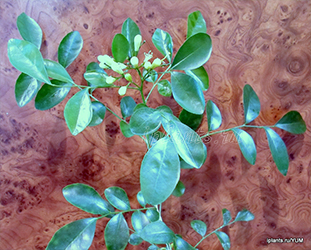 Murraya paniculata (Russia) in buds, 03/17/2016
Murraya paniculata (Russia) in buds, 03/17/2016
Murraya paniculata faded and tied, 05/20/2016
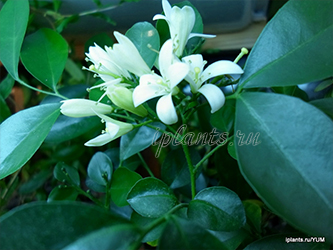 Murraya paniculata - one and adult bushes in bloom 03/18/2016
Murraya paniculata - one and adult bushes in bloom 03/18/2016
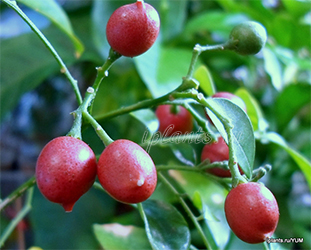 Murraya paniculata (Russia) - fruiting of an adult bush, 03/17/2016
Murraya paniculata (Russia) - fruiting of an adult bush, 03/17/2016
Murraya paniculata - ripe fruits, 05/03/2016
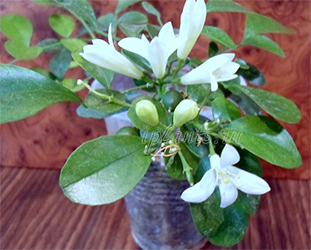 Blooming young murraya, 03/17/2016
Blooming young murraya, 03/17/2016
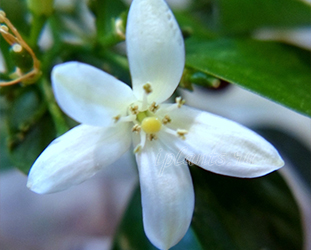 The flower is ready for pollination - the pollen is ripe, 03/17/2016
The flower is ready for pollination - the pollen is ripe, 03/17/2016
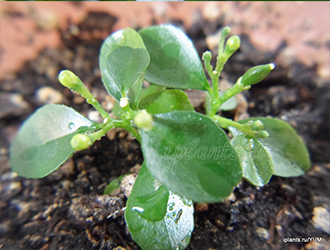 Two seeds in the fruit - bloomed and tied - from the cradle, 05/20/2016
Two seeds in the fruit - bloomed and tied - from the cradle, 05/20/2016
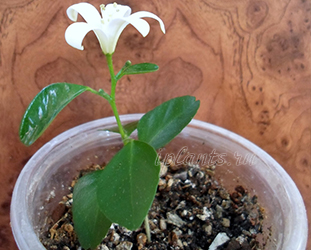 Another Murraya blooms from the cradle, 05/20/2016
Another Murraya blooms from the cradle, 05/20/2016
 This murraya flower has not matured pollen, 05/20/2016
This murraya flower has not matured pollen, 05/20/2016
General information
The Indians call muraya kari-phulia or kari-patta. Also, in some sources it is called him. The plant is a tree of modest size, whose height does not exceed 1.5 m.
The bark of the plant is colored gray-white, less often with a slight yellowness. The leaf plates have a deep dark green color.
 During the flowering period, the plant is covered with white flowers, and at the end of this period, an ovary with small scarlet berries is formed on the muraya, which have a significant similarity with the fruits of the hawthorn. The taste of these berries is quite piquant and there is a pronounced sweet note in it.
During the flowering period, the plant is covered with white flowers, and at the end of this period, an ovary with small scarlet berries is formed on the muraya, which have a significant similarity with the fruits of the hawthorn. The taste of these berries is quite piquant and there is a pronounced sweet note in it.
The use of foliage is common in cooking, as it has a rich lemon-citrus aroma with light jasmine notes.
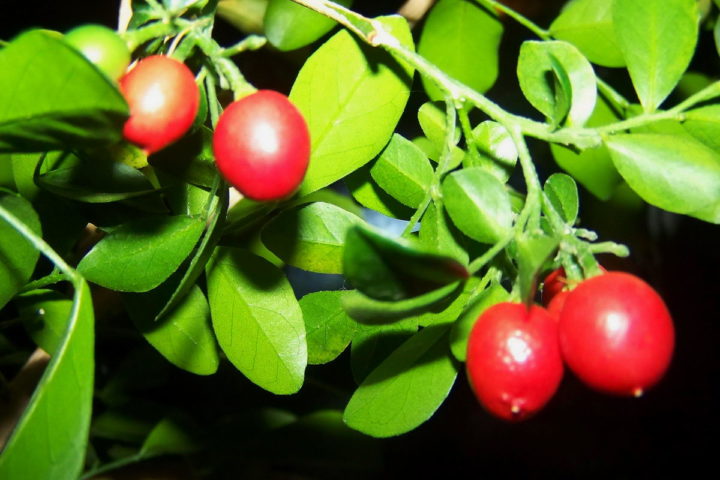
Interesting!
The peculiarity of such a plant is that blooming flowers, buds and ripening fruits can be present on one muraya tree at a time.


